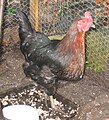Sex-link

Sex-links[1] are crossbred chickens whose color at hatching is differentiated by sex, thus making chick sexing an easier process. Sex-links come in several varieties. As hybrids of laying or dual-purpose breeds infused with extra vigor via heterosis, sex-links can be extremely good egg-layers which often produce 300 eggs a year or more depending on the quality of care and feed. The color of their eggs vary according to the mix of breeds, and blue-green eggs are possible.
Chicks of a single breed that are similarly sex-linked are called autosex chickens, a term developed to differentiate between sex linkage in purebred chickens versus sex linkage in crossbreeds.
Sex-link types
[edit]Many common varieties are known as the black sex-link (also called black stars) and the red sex-link (also called red stars).[2] More specific variety names are common as well.
- Black sex-link like "Black rocks" are a cross between unique specially bred hybrid strains of Rhode Island Red rooster (but any non-white and non barred rooster may be used for other black sex-link crosses) and a Barred Rock hen (which carry both extended black and barring genes).
- Red sex-links are a cross between a Rhode Island Red or New Hampshire rooster and a White Rock (This variety pair is known as a Golden Comet), Silver Laced Wyandotte, Rhode Island White, or Delaware hen.
Examples of a red-linked breeds include the Red Shaver and ISA Brown sex-links which are found in Canada.[3]
White birds should not be used in sex-linked crosses because white colour allele is sometimes dominant and sometimes recessive.[4]
Gallery
[edit]-
A red sex-link rooster
-
A Black Rock hen
-
A red sex-link pullet
-
A black sex-link rooster
-
Shipped pullets
-
Red sex-link hen
-
Black sex-link rooster







